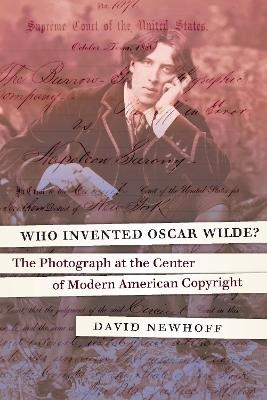
Who Invented Oscar Wilde?
Potomac Books Inc (Verlag)
978-1-64012-158-4 (ISBN)
- Lieferbar (Termin unbekannt)
- Versandkostenfrei innerhalb Deutschlands
- Auch auf Rechnung
- Verfügbarkeit in der Filiale vor Ort prüfen
- Artikel merken
AAP PROSE Award, Finalist in Media and Culture Studies 2021
In early 1882, before young Oscar Wilde embarked on his lecture tour across America, he posed for publicity photos taken by a famously eccentric New York photographer named Napoleon Sarony. Few would guess that one of those photographs would become the subject of the Supreme Court case that challenged copyright protection for all photography—a constitutional question that asked how a machine-made image could possibly be a work of human creativity.
Who Invented Oscar Wilde? is a story about the nature of authorship and the “convenient fiction” we call copyright. While a seemingly obscure topic, copyright has been a hotly contested issue almost since the day the internet became publicly accessible. The presumed obsolescence of authorial rights in this age of abundant access has fueled a debate that reaches far beyond the question of compensation for authors of works. Much of the literature on the subject is either highly academic, highly critical of copyright, or both.
With a light and balanced touch, David Newhoff makes a case for intellectual property law, tracing the concept of authorship from copyright’s ancient beginnings to its adoption in American culture to its eventual confrontation with photography and its relevance in the digital age. Newhoff tells a little-known story that will appeal to a broad spectrum of interests while making an argument that copyright is an essential ingredient to upholding the principles on which liberal democracy is founded.
David Newhoff is a freelance writer and communications consultant. As a copyright advocate he has worked with Copyright Alliance in Washington, DC; CreativeFuture in Los Angeles; and the Center for the Protection of Intellectual Property at George Mason School of Law. He founded the blog The Illusion of More and several of his essays have been cited in scholarly journals such as the Harvard Law Review, shared widely by legal experts and artists, and republished in Berklee Today, Allegro, and in both educational textbooks and online curricula.
List of Illustrations
Acknowledgments
Prologue: Eidolons
1. Dangerous Paradoxes
2. Copyright in a Few Snapshots
3. Stone Drawing
4. The Mencken
5. The Aesthetic Sham
6. The “Death of Chatterton” Case
7. The Girl (Boy) on the Tracks
8. “The Apparatus Can’t Mistake”
9. Who Invented Oscar Wilde?
10. The Wit of Macaulay v. Mickey Mouse
11. Monkeys and Selfies and “Monkey Selfies”
12. Art Is Theft
13. Invasive Species: When Machines Make Art
14. Who’s Inventing the Future?
Epilogue: Mirrors of Memory
Notes
Bibliography
Index
| Erscheinungsdatum | 30.10.2020 |
|---|---|
| Zusatzinfo | 15 photographs, 8 illustrations, index |
| Verlagsort | Dulles |
| Sprache | englisch |
| Maße | 152 x 229 mm |
| Themenwelt | Geisteswissenschaften ► Geschichte ► Allgemeine Geschichte |
| ISBN-10 | 1-64012-158-7 / 1640121587 |
| ISBN-13 | 978-1-64012-158-4 / 9781640121584 |
| Zustand | Neuware |
| Haben Sie eine Frage zum Produkt? |
aus dem Bereich


